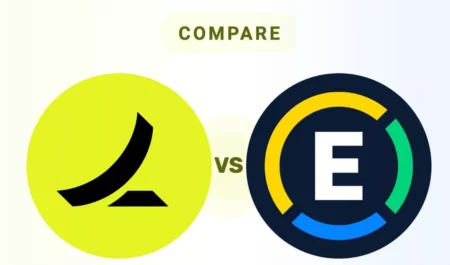33
As long as you link Ads and Search Console to other Google products, you can see how people use all of your websites together. But I did find that it can be too hard for beginners to understand and that the huge amount of info can be hard to get around.
On the other hand, Siteimprove offers itself as an all-in-one choice that has both data and tools for making websites better. It does a great job of giving you useful information that you can use to make your website better in terms of quality, usefulness, and SEO. Siteimprove makes tracking easy for people of all skill levels thanks to its user-friendly design. One thing that makes it unique is that it can find and rank issues with SEO, usefulness, and website content. As for the data from Siteimprove, I saw that it might not be as thorough as Google data in some ways.
Google Analytics vs Siteimprove: Comparison Table
The world of digital analytics is always changing. Choosing the right tool has helped me understand and improve my online profile. I’ve looked into the features of both Google Analytics and Siteimprove and made a thorough table that shows what each tool does well and where it might fall short. Whether you’re an experienced marketer like me or a business owner who wants to improve your online presence, this guide is meant to make it easy for you to make a choice.
| Feature | Google Analytics | Siteimprove |
|---|---|---|
| Primary Focus | Web Analytics | All-in-One Website Management Suite |
| Pricing | Free version available; Premium plans based on usage | Subscription-based pricing; Higher cost for full suite |
| User Interface | Robust, can be complex for beginners | Intuitive, user-friendly interface |
| Real-Time Reporting | Available, but with limitations | Limited real-time reporting capabilities |
| Integration with Other Tools | Seamless integration with Google Suite | Relies on external integrations for some features |
| Customization Options | Extensive customization features | Moderate customization options |
| Visit website | Visit website |
Google Analytics vs Siteimprove: Pricing Comparison
From my own experience, I know that Google Analytics’s free version is well-known and useful for many businesses, including mine. This free version has helped me a lot by giving me access to important analytics tools that let me keep an eye on website traffic, user behaviour, and other important data for my online presence. There are some things that the free version can’t do, though. For example, it can’t process as much data or give you access to more advanced tools.
This plan has been good for my business because it has advanced features like full website quality assurance, SEO optimisation, and accessibility monitoring, among other things. The subscription-based approach costs more, but I’ve found that it often gives me more control over how things work, more help, and the ability to grow. This makes it perfect for businesses like mine that have different and changing data needs.
Google Analytics vs Siteimprove: Ease of Use
From my own experience, I can say that Google Analytics really stands out because of how easy it is to use. The experience is smooth and easy to use if you’re already used to other Google goods. The integration with the full range of Google services makes the experience comfortable and familiar, which makes navigation easy and fast.
But Siteimprove is different because it focuses on making website optimisation jobs easier to do. It has a lot of tools to make websites run better, but I did notice that it took some time to get used to, especially for people who were new to the platform.
Google Analytics vs Siteimprove: Reporting Capabilities
From my own experience, Google Analytics has completely changed how I manage websites and do digital marketing. It’s more than just keeping track of metrics; it’s like having a digital compass that leads me through the complicated world of online success. I can get into specifics about website traffic, figure out how people act, and measure conversion rates with great accuracy. This much information gives me the power to make smart choices that will improve the user experience and help the business reach its goals.
This is the time to talk about Siteimprove. I think it’s very helpful that it looks at things from every angle. Siteimprove gives you a full picture of a website’s health, while Google Analytics is more focused on numbers. It does more than just keep track of traffic and user interactions; it also adds important features like accessibility and search engine optimisation (SEO) to its analysis tools. This gives me the chance to talk about more things that are important for the long-term growth of a website. As a website administrator, this in-depth knowledge has been very helpful in keeping the standard of the website high and making it even better.
Google Analytics vs Siteimprove: Integrations with Other Tools
Google Analytics is more than just a tool for people who work with Google, at least in my experience. A huge number of third-party tools work perfectly with it, which makes it very flexible. This gives me the freedom to use the programmes and tools I like best while still getting the full analytical power that Google Analytics provides. Google Analytics’s ability to integrate with other programmes lets me look at data and make decisions in a more complete way, whether I’m working with CRM systems, email marketing platforms, or e-commerce solutions.
In the same way, I’ve had good experiences with Siteimprove. Siteimprove offers connections with many platforms because they know how important it is for a tech stack to work together. So, Siteimprove is a great addition to the tools I already use, making it easier for people to work together and get things done quickly. The fact that Siteimprove works with other tools in my tech stack not only speeds up my work, but it also makes it more useful by combining its features with the best parts of other specialised apps.
Google Analytics vs Siteimprove: Customization Options
This has helped me a lot with figuring out how users behave, finding traffic sources, and figuring out how well my marketing is working. I’ve learned that Google Analytics helps me concentrate on the measures that are most important to my plans and goals. It’s easier for me to keep track of the key success indicators that matter for my online presence now that I can customise reports. This pair of tools has become very useful for making my website run better and give users a better experience.
As a result of my personal experience, I have discovered that Google Analytics offers a comprehensive collection of customisation choices, which enables me to adjust the platform to the particular requirements of more advanced users. On the other side, when I was utilising Siteimprove, I observed that there was a somewhat smaller selection of customisation options available. It would appear that Siteimprove places a higher priority on pre-defined optimisation ideas than it does on extensive user adaptation.
Google Analytics vs Siteimprove: Performance and Speed Comparison
From what I’ve seen, Google Analytics is a quick and easy way to handle and show data. It easily puts together a lot of data, including demographics, behaviour, and different measures about how well a website is doing. The platform gives almost instantaneous reports because it has a strong foundation and can easily integrate with other systems. This real-time access changes everything, especially for companies that need to know quickly in order to respond quickly to changing user behaviour or trends.
On the other hand, my experiences with Siteimprove have shown how useful it is as a tool, though its performance can vary based on how hard the optimisation tasks are. The speed at which Siteimprove gives you useful information can be affected by how complicated jobs like website content analysis, SEO improvements, and accessibility checks are. As the difficulty of these jobs rises, processing time also rises noticeably. This shows how important it is for users to carefully consider their optimisation goals before using Siteimprove.
Google Analytics vs Siteimprove: User Reviews and Testimonials

The simple interface makes it simple to find your way around, and the many reporting options let me dig deep into the website metrics that mean the most to me. The accuracy with which it tracks and analyses website traffic is great, giving me a lot of data-driven information that helps me make smart choices. It has been very helpful in making my marketing strategies work better and improving the general performance of my online presence.
In the same way, I’ve had a good experience with Siteimprove when it comes to optimising websites. With its wide range of features, this platform has made a name for itself, and I always praise it. Siteimprove has many ways to make online sites better, such as improving content quality and analytics, making them more accessible, and working on SEO. The easy-to-use tools that Siteimprove gives me have been very helpful in finding and fixing problems, making sure that my website is smooth and easy for people to use.
Which is Better?
When it comes to choosing between Google Analytics and Siteimprove for your company, my own personal experience has demonstrated that the decision is entirely dependent on the particular objectives that you wish to achieve. If you are primarily interested in acquiring in-depth insights through thorough analytics, I discovered that Google Analytics is typically the choice that is more ideal for your needs.
On the other hand, if you’re searching for a thorough method to optimise your website, particularly for mid-sized and corporate firms, my personal opinion based on experience is that Siteimprove could be the perfect option.
Google Analytics: The Good and The Bad
It’s very important to pick the right data and insights tool for digital marketing and website optimisation. Google Analytics and Siteimprove are two of the biggest names in this field. Both platforms have many features that are meant to make websites work better, give users a better experience, and improve your total online presence.
The Good
- Extensive analytics features
- Integration with other Google services
- Free version available
The Bad
- Learning curve for beginners
- Limited website optimization features
Siteimprove: The Good and The Bad
Google tracking has been one of the most popular digital tracking tools for a long time. It gives you a lot of useful information about how your website is doing and how people use it. It has become synonymous with web analytics because companies and marketers use it all the time. But as technology has improved, new options like Siteimprove have come up with their own features and functions.
The Good
- Comprehensive website optimization
- Tailored solutions for accessibility, SEO, and more
- Suitable for mid-sized and enterprise businesses
The Bad
- Subscription-based pricing
- Learning curve for comprehensive features
Questions and Answers
Is Google Analytics free to use?
The answer is yes; Google Analytics provides a free version that has a restricted set of functionality, making it available to companies of varying sizes.
What sets Siteimprove apart from other website optimization tools?
This complete strategy, which addresses accessibility, search engine optimisation, and content quality in addition to traditional analytics, is what sets Siteimprove apart from its competitors.
You Might Be Interested In










Leave a Reply